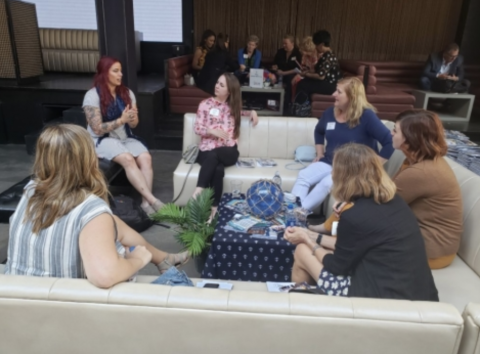How a Chicago Planner Event Mastered the Roundtable Discussion

When I first learned about Chicago Planner Master Class, I was intrigued. Put on by Ateema Media & Marketing, this series of events designed specifically for professional event planners and event marketers isn’t a typical talking-head education session or a loose networking opportunity. Instead, events (which take place several times a year) are structured as a brief introduction from a partner sponsor followed by 10 roundtable discussions on topics pre-selected by attendees.
I attended my first one last week and not only did I learn a lot, I was also impressed with the layout and flow of the event. Here are a few tips for planning your own event roundtables, based on Ateema’s success with this series.
Choose the right venue
The Master Class I attended took place at SX Sky Bar, in the recently overhauled Hotel Essex in Chicago’s South Loop. With a wide range of oversized, colorful furniture and unique nooks throughout the space, this new venue — also filled with natural light and overlooking Grant Park — lends itself perfectly to intimate group discussions. It was fun to flow through the space and pick a new perch, from a cozy booth to an Alice in Wonderland-esque high-backed chair to a low stool. In a typical ballroom setting with standard round tables, the structure of this event would not have been nearly as engaging.

Carefully explain the format to attendees ahead of time — several times
Ateema did a great job sending out informative email communications several days in advance of the event. This pre-event information, combined with an agenda handed out on-site (see below), ensured all participants knew exactly how the event would flow.
Pick relevant discussion topics
The discussion topics at the event were preselected in advance based on feedback from attendees, which was an excellent way to encourage participation and build interest. It’s important to pick relevant and timely topics that pique attendees’ interest (for example, we could have easily added a topic around health at events, based on the current coronavirus outbreak).
Here’s what we talked about in the class:
- How to draft a site plan while in a unique venue
- Questions to consider when partnering with a DMC
- Benefits of gamification at your events
- How to find local planner resources
- Digital marketing strategies for your next big event
- Using events as an outlet for CSR
- What to look for when inspecting a potential event site
- Choosing spatial assignments to best fit your event
- How to incorporate new technology into your event design
Make agendas that are easy to follow
Building schedules in advance and assigning each person an order of tables would have been complicated and time-consuming for event staff. Instead, a staffer simply had a stack of schedules and handed them out one by one, in no particular order, during registration. This was an easy way to ensure everyone had a unique schedule and groups would be randomized, so that you’d interact with different groups at each session.
Stick to the scheduled times
While the event intro kicked off about 10 minutes late, the rest of the morning went as planned: From 9AM to 12PM, attendees visited all 10 roundtable discussions, following the format of 1 minute for brief introductions, 3 minutes of sponsor pitch and then 10-12 minutes of group discussion. Event organizers raised the volume of the music when it was time to switch areas, an easy way to signal the transition without being intrusive. We had 2 minutes to migrate to the next table, just like musical chairs. Keeping to schedule meant there was no confusion over what was taking place, when.
Incorporate at least one active station
Two of the 10 stations featured something active. At one roundtable, we talked while making DIY candles from sand wax and fragrance in partnership with Live Art International (a company that sources live entertainment for groups), and another “roundtable” was a quick tour of Hotel Essex. We walked and talked quickly and got our blood flowing, which stimulated learning and knowledge retention from the morning.
Create sponsorship activations
Having a sponsor for each roundtable discussion was a killer way for event organizers to help cover their costs (or maybe even make a profit). For the most part, each sponsor was experienced with the topic at hand (for example, Luxe Productions led the group on new event technologies) and as such, attendees were keen to ask questions and be involved in the discussion.
Want to check out Chicago Master Planner Class for yourself? The next one is set for March 24 at City Winery; learn more here. Ateema also holds events in San Francisco.
How have you incorporated roundtable discussions into your events? What formats have brought you success, or what challenges have you learned from? Share with us in the comments or email me.
Don't miss any event-related news: sign up for our weekly e-Newsletter HERE and engage with us on Twitter, Facebook and LinkedIn!


Add new comment